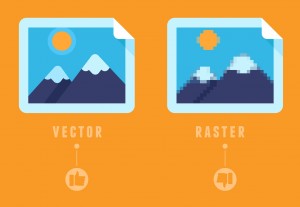You may not know what a vector file is or what they are used for. In the world of graphic design, and print, vector files make all the difference. Don’t worry, we will explain what they are and the power they have.
Usually vector files come in EPS format, but they can also be stored as PDF, PSD, and AI files. Vector files, unlike raster files (JPGs, PNGs, GIFs), are made up of many individual, scalable objects defined by mathematical equations rather than pixels, thus producing the highest quality image possible. You care about quality right?
A common misconception is that any image, regardless of format, can be enlarged, printed, and still look amazing. This misconception, however, does hold true for vector files. Why? As mentioned before vector-based images are created by using mathematical equations to define the shapes and points of the image. When you take the vector file and increase its size, the equation is recalculated accordingly.
As a result the image, even with the increase in size, does not lose any data or detail. Resolution will never be an issue with vector files either. (If you want to learn more about file resolution check out our blog Understanding File Resolution) This is also the case in the reserve scenario. Say you have a logo that you want to put on a business card. The vector logo can be reduced and not lose quality. Vector files are scalable without jeopardizing image quality, unlike bitmap/raster files.
Bitmap and raster files, like JPGs and GIFs, are typically found on the Web or are photos take with a digital camera. They are made up of grid of pixels or dots, that when enlarged do not scale to the desired size well. Instead the “dots” that once were unnoticeable can now be seen on a larger scale. When raster graphics are blown up, it will look blocky, or "pixelated” whereas the edges of a vector file remain smooth and clean.
So why else should vector files be used? Take a look at the other benefits of vector files.
1. Vector graphics look great in print, clean and precise lines
2. It is easier to re-edit vector files as its components can be individually manipulated
3. Ability to separate image from the background and pull apart elements
4. Certain attributes can be edited like color, outline, and fill
5. Vector images can be scaled to fit a billboard and won’t lose quality
6. They have smaller file sizes that are easier to transfer and if used in the web, are easier to load
7. Images can be created in outlines so the font never loads differently
8. Great for animation and presentations, clean and precise lines
If you liked this blog you might also be interested in reading: Understanding File Resolution and Its Importance in Print
Learn how Avalon’s secure print and mail services allow you to focus on the bigger picture.






